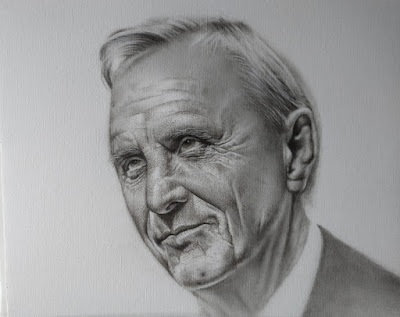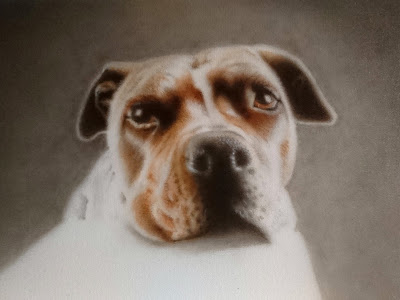Andre Hazes probably was one of the greatest Dutch ballad singers ever. Unfortunately he moved to more endearing venues, leaving his fans with an unforgettable legacy. I usually listen to Buckethead, Metallica or Earthtone 9, that sort of stuff, but I am moved by Hazes' voice. He was one of those rare talents that enter this dimension once every century or so; spirits that become artists who transcend partitions humankind stubbornly clings to. This is a freehand airbrush portrait that started out as a drawing and gradually evolved into a realistic portrait that preserved its pencil like fibre.
Controlled spattering
Toward the end controlled spattering (with the Iwata Custom SB) was done; turn pressure very low, just enough to push the paint out. Use undiluted paint (Inspire H2O acrylics), pull the trigger back all the way and release it. Repeat this rapidly, like tick, tick, tick - as fast as you read this. Start with Black Smoke, then very carefully and sparsely Base Black and finally Base White. If spattering turns out not like you want it, immediately hit the spot on the paper with the side of your hand or a tissue to remove the paint from the paper. That also works to soften the spattering, decrease its intensity. The low pressure and viscous undiluted paint will clog the airbrush (Iwata Custom SB) quite fast! So it's probably wise to clean your brush often and thoroughly in between colour changes or refills. I may make a Youtube clip of this technique some time.
Controlled spattering
Toward the end controlled spattering (with the Iwata Custom SB) was done; turn pressure very low, just enough to push the paint out. Use undiluted paint (Inspire H2O acrylics), pull the trigger back all the way and release it. Repeat this rapidly, like tick, tick, tick - as fast as you read this. Start with Black Smoke, then very carefully and sparsely Base Black and finally Base White. If spattering turns out not like you want it, immediately hit the spot on the paper with the side of your hand or a tissue to remove the paint from the paper. That also works to soften the spattering, decrease its intensity. The low pressure and viscous undiluted paint will clog the airbrush (Iwata Custom SB) quite fast! So it's probably wise to clean your brush often and thoroughly in between colour changes or refills. I may make a Youtube clip of this technique some time.
Oldest stage at the bottom, newest on top as always.























































